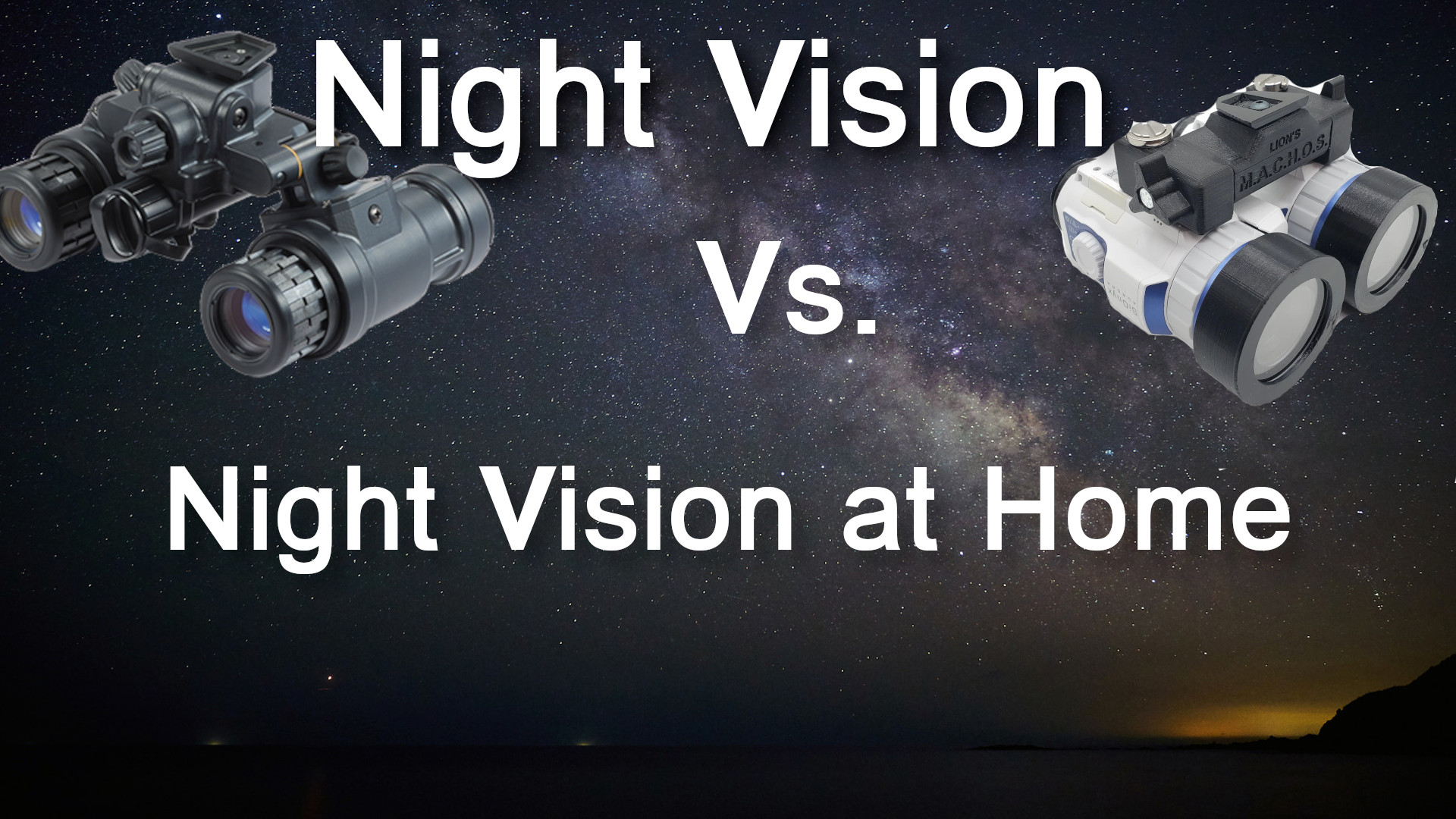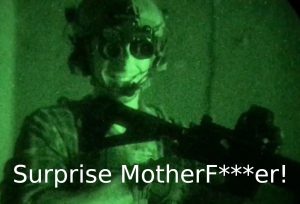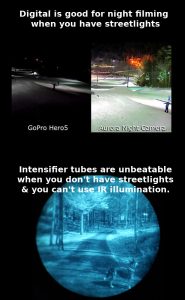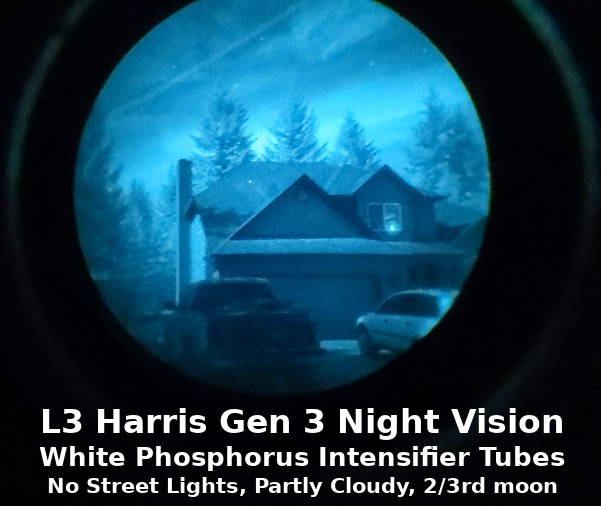
Digital versus analog night vision. A fancy optic won’t win a match for you, buying running shoes won’t fix your cardio. But, NVGs will make you see when it’s pitch black to everyone else. For anyone interested in anything tactical, ever, NVG is undeniably cool. I think we all know why.
But unless you’re in the Taliban, you better bring money, lots of money. Even people with a SCAR-h budget balk at the cost of playing the low-light game. A decent military style PVS-14 monocular (one eye only) costs $2,500-$5,000 at the time of filming. Dual tubes are $5,000-$10,000. Yes, you can go a bit cheaper if you make sacrifices. But still: BRING MONEY! So, anything that will scratch the low light itch on a budget is tempting. The age of Amazon Prime leads one to believe that we deserve low light tech in an affordable platform with free express shipping. Enter the Sionyx Aurora, which starts around $500 bucks.
My biggest disappointment when I finally got night vision stuff is not getting the bweeeee noise like on cod. The sionyx makes light saber noises, so I guess “we have night vision at home”.
When it comes to seeing in the dark, prices range from a few hundred dollars to many thousands of dollars. Some guys have even gone so far as to adapt dual Auroras onto helmet bridge mounts, thus getting a semblance of dual tube goggles for less than 2 grand. For casual users and civilians on a budget, the Aurora has become the favored digital unit. But, is digital night vision just as good? If it’s not just as good, is it good enough? The short answer is no, the Aurora is not just as good. But, it’s still better than nothing. Compared to the Aurora, intensifier tubes are still king, but that’s not the end of the story. At the end of this video, we’ll consider the future of seeing in the dark. Spoiler alert: the future of night vision looks like digital will be a lot more competitive, enter the Sionyx Opsin.
Let’s cover some basics about how night vision works. Intensifier tubes are made from very complicated lab-grown crystals that amplify light when electrical current is applied. Digital night vision uses a camera sensor with the infrared filter removed along with a software system that is optimized for low light conditions. Thermal devices like FLIR (Forward Looking InfraRed) are different than night vision devices in that they detect temperature differences, like the alien on the movie Predator. Thermal imaging can be very useful for hunting animals in the dark and spotting would-be intruders, but is not the best for helmet-mounted land navigation. For the comparison between digital and intensifier tubes, we won’t be considering thermal imaging devices like FLIR. For real though, I’m working on getting my hands on a thermal scope so stay tuned.
While Thermal sensing devices can “see” in absolute darkness, so long as there’s temperature variation, digital and intensifier tube systems both need a tiny amount of light to resolve an image. For example, If you tried to use NODs in a cave far underground, you wouldn’t be able to see anything. That’s because there’s no ambient light to amplify. Night vision works by amplifying light so that we can see it: no light means nothing to amplify. But the more you amplify, the dirtier the signal gets. Another useful feature of night vision is that they can also sense some IR (InfraRed) light. Sensing IR light means that you can use IR lasers and flashlights that shine brightly to those wearing NVG, but are invisible to the naked eye.
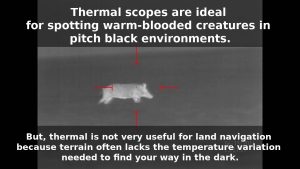
Modern intensifier tube NVGs can function reasonably well with a small amount of starlight, even if it’s diffused through clouds. Even though both need a tiny amount of light, the Sionyx Aurora needs a lot more ambient light to function because it’s just not sensitive enough to function on starlight alone. Some other YouTube channels you’ve seen on the Sionyx Aurora make it look great, but there’s a catch. The Aurora looks good when it films in open country under a good moon or near the city. The problem with the Aurora is that its performance falls off a steep cliff when the moon isn’t bright or there aren’t city lights. Analog night vision absolutely destroys the Aurora in truly dark night-time conditions. The Aurora is better than the naked eye, but it’s not as good as “real” night vision. Hopefully the new Opsin solves these shortcomings of digital.
Because digital night vision like the Aurora needs more ambient light, you’ll often be relying heavily on artificial light sources in the infrared spectrum. IR (infrared) light is invisible to humans and animals, but can easily be seen by anyone else with night-fighting capability. If your goal is night observation when nobody else has NVG then a digital unit may be a good value… You can see them but they can’t see you. But, if someone else has even basic night capability they’ll pick up your IR signature from a literal mile away. Interestingly, the weakness of digital is also a use case. Maybe you can’t afford intensifier tubes but you need a way to observe others using IR devices. With a basic Aurora, you could hide in the shadows and effectively scan for IR activity. You’d also being doing much better than anyone with no night vision at all. And, in situations where the moon is 75%+ illumination you’d be able to see great.
Some very high end digital cameras are greatly improving their light sensitivity, but they’re still less sensitive than analog intensifier tubes. Even with analog tubes, you’ll find yourself frequently using active IR light to identify concealed targets at distance. But, you won’t need IR light on continuously just to move around like you would with a digital unit. At some point, I expect digital performance to surpass analog, or at least get close. While I haven’t tried out the Sionyx Opsin yet. There’s a chance that the Opsin may be able to truly compete with real night vision.
The Future of Night Vision
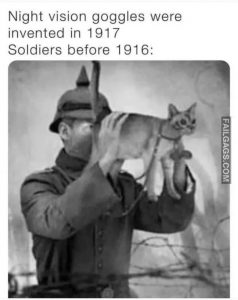
The future of night vision looks pretty awesome, so long as you have a lot of money. Let’s get into it. Over the last year, I’ve started to see 4th generation analog night vision come on the market. These gen 4 units promise even better light sensitivity along with higher resolution too. Based on the filmless white phosphor pinnacle tubes I’ve tested out, I can only imagine what a proper gen 4 tube would do. Higher performance, lighter weight, analog technology seems to still be advancing. That said, digital may finally be on the cusp of making good on its earlier promises with the arrival of the new Opsin digital monocular. At the time of this writing, I have not yet tried the Opsin myself, but it seems plausible that for its $2,500- sticker price, they’d make it meet or beat comparable analog PVS-14 offerings.
Image Lag & Exposure Time

Other than lack of low light sensitivity, the biggest problem that some users report with digital units is lagging refresh rate. This means that as you move around quickly in a dark environment, the image that you see is somewhat delayed compared to real life. Analog tubes work nearly as fast as the speed of light, so lag isn’t a problem. However, digital units use a micro computer processor to process the image and render it on a display. This computer process results in lag. Cameras work based on frame rate and image exposure time. The darker it is, the longer the camera needs to expose the image in order to resolve it. Lower light means longer exposure is needed. This means that in very dark environments, the longer exposure of digital units makes the lag even worse. More powerful camera sensors and better computer chips can mitigate lag, but they can’t quite get rid of it entirely. In the future, digital night vision lag may get so low that it’s a non issue, but it will still be there a tiny bit.
Digital Night Vision: Size, Weight, Packaging

Other than light sensitivity, image quality and lag, there’s another significant potential advantage that future computerized NVG can have. The Aurora and the Opsin as well as analog units are all long tubes that hang off of a head-mount in front of your eyes. While modern analog dual tubes seem light at around one US pound, the weight seems heavy when it’s dangling off of a helmet mount out in your face. Getting in and out of cars and trucks and navigating enclosed spaces, I’ve snagged my NODs more than once. Another problem is the very limited field of view. NVG’s normally have a 40* field of view, some have up to 50*, which is still very narrow.
With traditional NODs, most of these design constraints can’t be easily avoided because light travels through the tubes in a line. So, you’re left with a long “toilet paper tube” hanging off your face. But with digital these constraints don’t apply. Also, with digital you could move the digital processor to the back of the helmet (or even to the torso) along with the batteries to balance out the weight a bit. A pound hanging off your head takes a toll after several hours. The only things you need in line with the wearer’s eye are the camera sensor(s) and the display. Because of this, I can imagine a future where the wearer has thin glasses with a panoramic augmented reality display that give them gen 3 or better low light performance without the downsides of analog tubes.
Performance
There’s more to operating in the dark than simple low light performance, and here digital may also have an advantage in the future. Digital devices open the door to displaying additional info to the wearer that may be useful. Info like time, navigation instructions, operational data and even thermal body heat signatures could all be incorporated into the digital display with the right auxiliary sensors and data. Devices like the InfiRay Jerry-C and the E-COTI provide some of this functionality to analog, but at a significant additional cost and even worse, extra weight.
Night vision, thermal imaging and digital technology are many things at once: exciting, expensive and terrifying if you’re on the wrong side of them. Given enough time, my guess is that digital will eventually “own the night”. Nonetheless, my current go-to is a set of dual tube gen 3 white phosphor NODs. While the Sionyx Aurora can’t compete with units costing 10x the price, it’s an interesting way to dip your toe in the water of seeing stuff at night. While I haven’t tried the Opsin yet, I’m excited to get one and figure out how well it performs compared to the military style PVS14 monocular.
If you take things like “being ready” and “self reliance” seriously, you should probably make plans in the budget to get some sort of low light device. Maybe even an entry level thermal handheld and a single PVS14 would get you a long way. If money’s really tight, consider selling a spare pistol and getting a used Aurora, but seriously consider saving for a basic PVS-14 and you’ll be happier. Whatever you do, just get something and build from there.
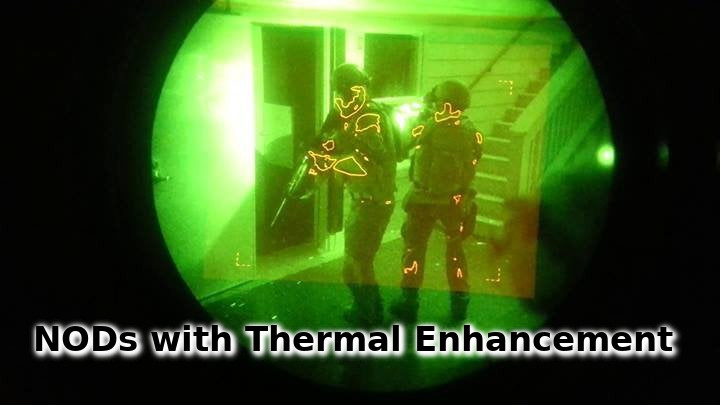
- Analog Intensifier Tube
- These are the helmet-mounted devices that you’ve probably seen used in action movies. They use lenses to focus light into “image intensifier tubes” that greatly amplify whatever tiny amount of light is available and also pick up light within the normally invisible infrared spectrum. Pros to an analog intensifier tube is that it doesn’t rely on microprocessors so there’s no lag in the display like there is with digital. Also, the image intensifier tubes used in analog systems, currently available in their third generation, require far less ambient light than digital night vision.
BNVG systems like the AN / PVS 31 A are currently in use by US military as one of their commonly issued pieces of spec ops gear.- Requires far less ambient light than digital (Gen 2 & Gen 3)
- Much longer battery life than digital & thermal
- Waterproof, military-grade technology
- Greater stealth. You won’t usually need IR illumination outdoors
Pros:
- Heavy & bulky
- Limited field of view (most NODs have a 40-50* field of view, even with binocular systems)
- Expensive! Cheap gen 2 monoculars are close to $2,000 and Gen 3 binocular NVGs can approach and even exceed $10,000.
Cons:
Best Use Cases: Analog intensifier tube is best in tactical situations in low light conditions where you face well-armed opponents. Military & law enforcement. Driving. Star-gazing.
- Digital
- This type of device uses digital camera sensors and lenses that are able to pick up light in the infrared spectrum. These digital NODs require a lot of ambient light compared to analog setups so they come with very bright infrared (IR) illuminators. Infrared light is invisible to humans and animals so you’re in the clear, right? Well, sort of but not really. If you’re using digital NVGs anyone else with night vision will see you lit up as if you had a huge spotlight taped to your helmet. The other downside of digital NVG is that the image has to be taken in, processed in a tiny computer and then displayed for the user on a monitor that the user looks into. These computer processes take a few milliseconds to complete, which can disorient the user if you’re trying to move around quickly in the dark while engaging hostile opponents. On the other hand, digital is the most affordable option and it usually allows you to record video and images right from your device.
- Affordable
- Can record low light video
- More flexibility on packaging
Pros:
- Lower battery life than analog.
- Digital processors have enough lag to make head mounted use impractical.
- Requires IR spotlight to work. Bad guys with NODs will be able see your IR illumination from 100’s to 1000’s of yards away.
Cons:
Best Use Cases: Digital is best as en economical way to get into low light technology for hunting and static observation (aka not head mounted). Has some limited utility for perimeter defense in civil unrest situations where opponents are not well armed (aka, if the bad guys don’t have NVG).
- Thermal
-
Thermal devices like FLIR are not a true “night vision” in the sense of image intensification, but they are very effective at spotting living things with heat signatures in the dark. Similar to the images depicted in the Sci-Fi movie Predator, thermal imaging devices allow the user to see objects which are a different temperature than their surroundings. Thermal is great for hunters trying to spot game in the dark and is also useful for security teams observing an area for intruders.
While thermal is amazing at spotting game (and would-be intruders) in the dark, it’s not very useful for head mounted land navigation. This is because plants, bushes and terrain features can all be a very similar temperature. Sure, you can spot a feral hog in pitch black, but you might not be able to see a hole in the ground right in front of you. Also, while you could recognize a human on thermal, you couldn’t tell who the person is or what they’re wearing. For example, you may not be able to tell the difference between a police officer and a would-be criminal through thermal imaging.Thermal imaging has a ton of other uses. For example, you can see the heat signatures coming off of car engines that have been driven recently or guns that have been shot. For law enforcement, thermal can be a great way to find suspects who may be concealed or camouflaged. Thermal also has industrial/commercial applications for checking building insulation and looking for leaks.
Top of the line military NVG can be outfitted with an optional thermal add-on systems like the E-COTI (AN/PAS-29B Enhanced Clip On Thermal Imager) that gives the wearer the benefits of thermal being added to gen 3 intensifier tube systems. While the military grade E-COTI runs about $9,000- in late 2022, the civilian market now has the option of imported versions from iRay like the Jerry-C Clip On Thermal. I’d love to pick up an iRay Jerry-C for review at some point, so if you have one feel free to reach out.
- Requires zero ambient light to function
- Can instantly spot heat signatures in a cluttered environment
- Mammals, cars that have been driven recently, surfaces that have been touched recently and recently fired firearms are all easily spotted because they are warm
- Can be used day or night to help identify targets with heat signatures
Pros:
- Expensive! In many cases, thermal can cost even more than some NVG.
- You can’t use thermal (on its own) to walk around in the dark. Thermal is not useful for land navigation because objects in the environments often don’t have much temperature variations
- Lower resolution than modern analog image intensifiers
- Can’t identify uniforms or identity of people using thermal
Cons:
Best Use Cases: Thermal is great for static observation, low lgiht hunting and law enforcement applications. For hunters, combining wearable NODs along with a thermal rifle-scope or spotting-scope can be a great combination. For those with the budget, having thermal as an add-on to conventional NVG can be a huge force multiplier on the battlefield.
